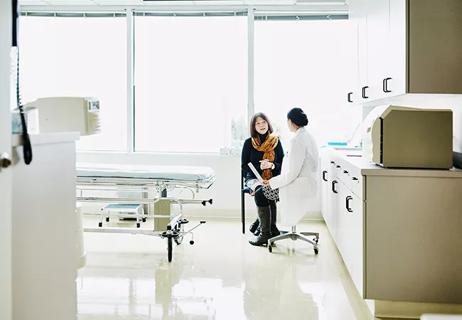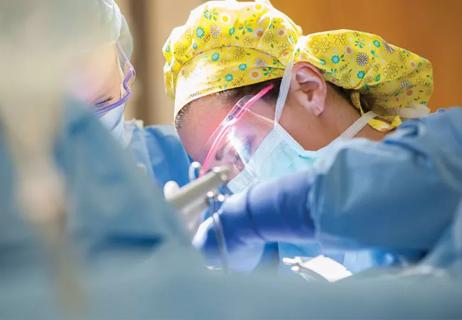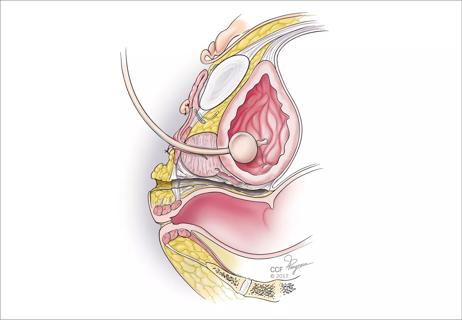Randomized trial shows no difference in outcomes

Approximately 200,000 surgical procedures are performed annually for the repair of vaginal apex prolapse, and mesh grafts are commonly used to reconstruct the pelvic floor. In addition, repair is increasingly being performed via laparoscopic sacrocolpopexy (LSC) and robotic-assisted sacrocolpopexy (RSC), which offer decreased morbidity and faster patient recovery with similar surgical success rates to an open abdominal procedure.
Cleveland Clinic is a non-profit academic medical center. Advertising on our site helps support our mission. We do not endorse non-Cleveland Clinic products or services. Policy
With an eye toward improving operating room (OR) efficiency and decreasing costs, Cleveland Clinic surgeons performed a randomized, single-blinded trial of two types of mesh grafts—Restorelle® Smartmesh Y mesh and Smartmesh flat mesh—to determine if there was a reduction in case time or placement time.
“Our secondary objective was to compare adverse events, subjective patient symptoms, prolapse recurrence and the incidence of mesh erosion between the two mesh configurations,” reports Cecile A. Ferrando, MD, MPH, a surgeon in the Center for Urogynecology & Pelvic Reconstructive Surgery, Department of Obstetrics, Gynecology & Women’s Health Institute at Cleveland Clinic. Dr. Ferrando performed the study, which was published in Female Pelvic Medicine & Reconstructive Surgery, with her colleague Marie Fidela Paraiso, MD. The study was supported by an unrestricted research grant from Coloplast, makers of the Restorelle Smartmesh products.
“Cost of health care is a hot topic in the medical and surgical communities,” says Dr. Paraiso, “and surgeons can make contributions to savings by reducing equipment needs and facilitating case setup times—and by choosing materials that make certain procedures faster and more efficient to perform.”
The Y mesh graft is configured in a Y shape and only needs to be introduced into the pelvis once, with arms fixed to the anterior and posterior vaginal walls. In contrast, the flat mesh can be cut and preconfigured by the surgeon into a Y shape and introduced into the pelvis once, or used as two separate arms that are introduced separately into the pelvis and secured together to the sacrum after being attached to the vagina.
In this study, the surgeons introduced the flat mesh twice, starting with the anterior mesh arm, followed by the posterior mesh arm. The two arms were then brought to the sacral promontory and sutured together to the anterior longitudinal ligament. “Prior to this study, it was unclear which mesh was faster to use and if this translated into a cost savings in the OR,” explains Dr. Paraiso.
The randomized, single-blind trial enrolled 62 women ages 18 years and older with post-hysterectomy vaginal prolapse who were undergoing LSC or RSC. One of the two types of mesh was implanted in 59 subjects: 30 received the Y mesh (17 LSC, 13 RSC) and 29 received the flat mesh (18 LSC, 11 RSC). LSC was performed using four ports and RSC was performed using five ports and the da Vinci® surgical system.
The two surgeons found that there was no difference in mean placement time between the two groups at 46.1±13.5 minutes. Mean case time was also similar at 204.4±48 minutes. In addition, at six months, all patients had significant improvement in their symptoms as measured on the 20-item Pelvic Floor Disability Index (PFDI), and there were no differences in subjective recurrences, objective recurrences or mesh erosions. Subjective success of the procedures at six months was 94% and objective success was 100% for both types of mesh.
Many institutions use the Y mesh, reports Dr. Ferrando, who suspects that it is more commonly employed than the flat mesh because it is easier to learn how to use it for sacrocolpopexy. However, some surgeons may prefer the flat mesh because they can customize the tension on each arm separately.
“We thought there would be a difference in mesh placement time between the two types of mesh configurations,” adds Dr. Paraiso, “but it is possible that our vast experience with using both types of these meshes facilitated our operations despite the involvement of our fellows in these cases.”
The findings led the two surgeons to conclude that “the additional cost of the Y mesh (approximately $100) is not likely to be offset by improved OR efficiency and reduction in operating time,” says Dr. Ferrando. This type of information is helpful for surgeons when they are making decisions about cost-effectiveness, especially if they are skilled in using both types of mesh. Dr. Paraiso adds, “A pelvic floor surgeon may use what is best in his/her hands.”
The two investigators intend to continue to study outcomes related to sacrocolpopexy, including those associated with the use of different meshes. “Our goal is to provide value-based, high-quality care for our patients, which is why we make concerted efforts within our section to perform research studies that advance and improve patient care,” Dr. Paraiso says.

Deprivation is linked to impaired glucose intolerance and racial disparities

Artesunate ointment is safe well and tolerated patients with vulvar intraepithelial neoplasia

A case-based discussion of efficacy, eligibility and use

Workshop curriculum was valued by some, while others would have preferred time for themselves

Study finds lower incidence of endometriosis than in cisgender patients

Large randomized study compares embryo growth kinetics and live birth rates between culture media

Surgeon experience is key to reducing adverse events

Introducing Laura Detti, MD, newly appointed Chair of the Department of Subspecialty Care for Women’s Health